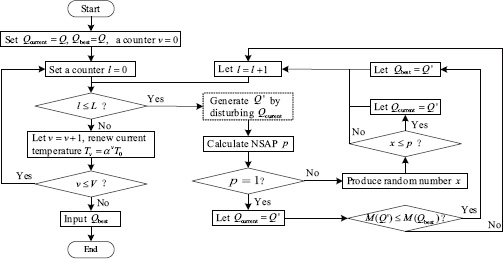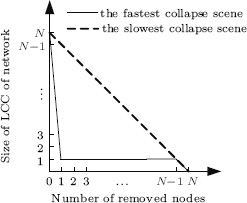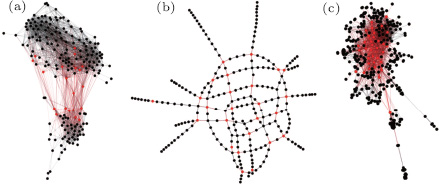† Corresponding author. E-mail:
Project supported by the National Natural Science Foundation of China (Grant No. 61573017) and the Natural Science Foundation of Shaanxi Province, China (Grant No. 2016JQ6062).
In this paper, based on simulated annealing a new method to rank important nodes in complex networks is presented. First, the concept of an importance sequence (IS) to describe the relative importance of nodes in complex networks is defined. Then, a measure used to evaluate the reasonability of an IS is designed. By comparing an IS and the measure of its reasonability to a state of complex networks and the energy of the state, respectively, the method finds the ground state of complex networks by simulated annealing. In other words, the method can construct a most reasonable IS. The results of experiments on real and artificial networks show that this ranking method not only is effective but also can be applied to different kinds of complex networks.
It is of great significance in real life to take full advantage of important nodes in complex networks. For example, protecting and backing up key routers and servers in the internet will reduce the damage caused by network attacks, building an integrated transportation hub for main traffic junctions in road networks will alleviate traffic congestion, and issuing information through authorized media or high-profile persons in social networks will guide public opinion more effectively. Due to their huge utility, how to identify important nodes in complex networks has been a wide concern.[1–3]
Methods of ranking nodes in complex networks usually use the topological properties of nodes to judge their importance. Commonly, these ranking methods are divided into a single-index ranking method (SRM) and multiple-index ranking method (MRM). As the name suggests, SRM evaluates the importance of nodes with only one topological property of these nodes, such as degree centrality, betweenness centrality, and closeness centrality. Besides, Singh et al. proposed structural centrality to measure the importance of nodes, which was defined on the basis of a generalized inverse matrix of a Laplacian matrix of a complex network and reflected the distance from a node to other nodes.[4] Nie et al. constructed a new index to rank nodes according to the view that the more important the neighbor nodes of a node, the more important the node was.[5] Unlike what was done in Ref. [5], Hu et al. considered the contributions made by both neighbor nodes and non-neighbor nodes of a node to the importance of this node[6] while Liu et al. took the contribution of each edge of a node into account.[7] Compared with SRM, MRM is thought to be very accurate because it uses several topological properties of nodes to assess their importance. The main step of MRM is to integrate typical topological properties of nodes into a comprehensive measure of node importance through linear or nonlinear transition. The way of integrating topological properties is divided into a multi-attribute decision making method and a data dimension reduction method. The widely adopted multi-attribute decision making methods in ranking nodes include an ideal point method[8–11] and a hierarchy analytic method[12] while the commonly used data dimension reduction methods are the principal component analysis method[13] and the local linear embedded method.[14] Except for the ranking methods mentioned above, some researchers explored other ways. For example, Ventresca et al. searched for important nodes through a multi-objective evolutionary algorithm[15] and Xiao established a super-network model for evaluating the node importance.[16]
It can be seen from most researches that before ranking nodes, an index set constituted by one or several topological properties of nodes should be determined. But unfortunately, it is difficult to prove the completeness of an index set used in measuring the node importance. Thus, in this paper we try a different way to rank nodes by bringing in the simulated annealing method so that constructing an index set of nodes is not needed any more. At the end of this paper, the effectiveness of the new ranking method is demonstrated through an experiment on real and artificial complex networks.
In the field of condensed matter physics, annealing is an important way to obtain a solid substance in a low-energy state. The detailed process of annealing is that a solid substance is heated until it melts to liquid and then the temperature of the liquid is controlled to drop slowly until the liquid freeze to solid. During the fusion of the solid substance, the particles of the substance are transformed from a highly structured state to a disordered state, which is helpful to eliminate the inhomogeneity of particle distribution in the substance. During the solidification of a liquid substance, the particle distribution of the substance turns out to be uniform. As a result, the finally solidified substance will stay in a low-energy state called the ground state, which means that it is stable and has the least energy.
In order to simulate the state change of a substance during the solidification of a liquid, Metropolis et al. proposed an effective way.[17] Suppose that the current state of a substance is S = si and a new state sj is obtained from a slight disturbance of si, such as moving the position of a particle of the substance that stays in si then the next state of the substance will be
 | (1) |
 | (2) |
If the initial state of a liquid substance is known, then a state sequence can be constructed according to the rule introduced above. Since the next state of the substance is only related to its current state, a state sequence constructed can be treated as a Markov chain. Under a certain temperature T, the steady distribution of the Markov chain is the Boltzmann distribution. In other words, if the set H = {s1, s2, …} is constituted by all states that may appear in the annealing process, then the possibility of the event that the substance state changes from sx (sx ∈ H) to sy (sy ∈ H) after a series of state transitions is
 | (3) |
Suppose that the state sz (sz ∈ H) is the ground state of the substance, then according to formula (
The rank result of important nodes in a complex network can be represented by a node sequence. In the sequence, that the position of a node A is in front of the position of a node B indicates that node A is more important than node B. As a result, the most important node is the first one in the sequence while the least important node is the last one in the sequence. Such a node sequence of a complex network is called an importance sequence in this paper.
Since different ranking methods result in different important sequences, how to judge the reasonability of an important sequence becomes quite critical. It is well known that removing important nodes in complex networks will cause great damage to the networks. In other words, if nodes in a complex network are removed one by one according to their order in an important sequence, then the complex network will collapse quickly. The more reasonable the important sequence, the faster the collapse speed of the network is. Suppose that G is a complex network containing N nodes and Q is an important sequence of G. If the nodes in G are removed one by one according to their order in Q, then the collapse speed of G is defined as
 | (4) |
If a complex network G is compared to a substance, an important sequence Q of G is compared to a state of the substance and the reasonability measure M(Q) is compared to the energy of the state, then the ground state of G can be found by means of the simulated annealing introduced in Section
The detailed flow chart of our ranking method based on simulated annealing is shown in Fig.
The detailed process of generating Q' by disturbing Qcurrent in the dotted line box in the figure is as follows. Choose a pair of nodes in Qcurrent randomly and then exchange their positions. A new importance sequence obtained just through this operation is Q'.
If the parameters of the ranking method based on simulated annealing are well set, the most reasonable important sequence will be found finally no matter what the initial important sequence is. Thus, we set the initial temperature T0 to be
 | (5) |
The fastest collapse scene appears if the hub node of a star network is first removed from the network while the slowest collapse scene happens if the nodes of a network which is a complete graph are removed. According to Fig.
To validate the effectiveness of the proposed ranking method, it is tested on different real networks and artificial networks. The used real networks are the network of Jazz musicians (NJM),[19] the network of the Beijing subway (NBS),[20] and the network of American airlines (NAA),[21] whose information is shown in Table
| Table 1. Information of real networks. . |
We apply the proposed method to the real networks mentioned above. The results are shown in Fig.
If the nodes marked in Fig.
 | Fig. 4. (color online) Variations of size of LCC with the number of removed nodes of real networks: (a) NJM, (b) NBS, (c) NAA. |
The more reasonable the important sequence, the faster the collapse speed of a corresponding network is. According to Fig.
To compare these methods further, in this paper we run them on 9 artificial networks (ANs) whose information is shown in Table
 | Fig. 5. (color online) Variations of size change of LCC with the number of removed nodes of artificial networks: (a) AN1, (b) AN2, (c) AN3, (d) AN4, (e) AN5, (f) AN6, (g) AN7, (h) AN8, (i) AN9. |
| Table 2. Information of artificial networks. . |
It is well known that the scale-free network tends to collapse more quickly than the random network when both of them are under malicious node attack. The experimental results in Fig.
Though the ranking method based on simulated annealing (MSA) performs well in our experiment, its computational complexity reaches O(LVN3) while those of MME and the ranking method based on simulated annealing are O(N) and O(N3). As a result, the average time cost of the ranking method based on simulated annealing is 3.7 h when running on the artificial complex networks shown in Table
In this paper we study the nodes ranking problem in complex networks and propose a new ranking method based on simulated annealing. The proposed method describes the concept of node importance sequence and defines a reasonability measure for it. By comparing an important sequence and its reasonability measure to a state of complex network and the energy of the state, respectively, this method constructs the most reasonable important sequence with the help of simulated annealing. At the end of this paper, the effectiveness of the new method is validated through experiments on different types of complex networks. In the future, we will be devoted to reducing the computational complexity of this method for its practicability in large-scale complex networks.
| [1] | |
| [2] | |
| [3] | |
| [4] | |
| [5] | |
| [6] | |
| [7] | |
| [8] | |
| [9] | |
| [10] | |
| [11] | |
| [12] | |
| [13] | |
| [14] | |
| [15] | |
| [16] | |
| [17] | |
| [18] | |
| [19] | |
| [20] | |
| [21] |




